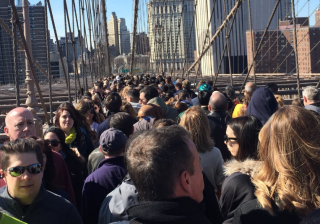Council Members Propose Widening Brooklyn Bridge Bike-Ped Path

Council Members Brad Lander, Margaret Chin, and Stephen Levin — along with advocates from Transportation Alternatives — stood at the Manhattan entrance to the Brooklyn Bridge this morning and put forth a proposal to expand the bridge’s increasingly popular and exceedingly cramped bike and pedestrian path.
“It’s about time, in 2012, that we update it a little bit,” said Lander.
This announcement comes as a response to several years of rising pedestrian and bike traffic on the bridge. As the number of cyclists crossing the Brooklyn Bridge surpasses an average of 3,000 daily, and the number of tourists and walk-to-work commuters exceeds 4,000, according to NYC DOT, the potential for conflict and collisions has grown. While the daily tabloids have sensationalized the competition for space, there’s no doubt that it’s real and that something must be done about it.
The most recent efforts to address this issue have been the “pedestrian safety managers” that were hired by the city to ensure safety on the bridge. But as Levin said, “there is a limit to what can be done with management of the path.”
Currently the path ranges from eight feet to 16 feet wide, not including wider sections where the path passes the bridge buttresses. (It was also narrowed by three feet in some places due to reconstruction work that began in 2010.) The proposal unveiled today would widen the path to 34 feet, providing significantly more space for both pedestrians and cyclists.
The crux of the proposal is to expand the path so that the entire length is as wide as the sections that extend out and over the roadway in order to pass the buttresses. Extending the more generous width to the whole length of the bridge would allow for the creation of a two-way, separated bike path and a tripling of the space dedicated to pedestrians.

The purpose of today’s announcement was simply to begin a serious discussion among city officials and agencies about a redesign of the Brooklyn Bridge path. Obviously there are some large questions that still need to be addressed, chief among them the construction cost. As of yet, there are no estimates of the total project cost, though Levin stated that it would most likely be “on the low end of infrastructure projects” and could draw funds from all levels of government. The council members also said their proposal shouldn’t pose a problem in terms of preservation, pointing out the many alterations that have already been made to the bridge over the years without detracting from its historic integrity.
While the time frame for the project is unclear, the council members suggested that it could possibly be integrated into current plans to redesign the Brooklyn side of the bridge approach at Tillary Street. Regardless, said Levin, “It will have to be done eventually.”
